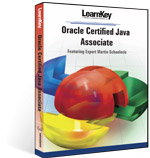|
Certified
Java Associate Course - CJAC - 

|
Description
Oracle Certified Java Associate course is designed to enable students with
little or no programming experience to begin to learn programming using
the Java programming language. The course teaches the significance of object-oriented
programming, the keywords and constructs of the Java programming language,
and the steps required to create simple Java technology programs. Students
taking this course can receive a solid basis in the Java programming language
upon which to base continued work and training. The course features the
Java Platform, Standard Edition 6 (Java SE 6) platform, and uses the Java
SE Development Kit 6 (JDK 6) product.
The Oracle Certified Associate, Java SE 5/SE 6 certification provides an
ideal entry into an application development or a software project management
career using Java technologies. This worldwide credential validates basic
knowledge of Object-Oriented Concepts, UML representation of OO concepts,
the Java programming language, and general knowledge of Java Platforms and
Technologies. Candidates for this exam include: entry level Java programmers,
students studying to become Java programmers, project or program managers
working with Java technology in the software development industry. This
course prepares you fully to sit the exam 1Z0-850/CX-310-019.
Benefits
 In-depth understanding
of Object-Oriented programming In-depth understanding
of Object-Oriented programming
 Differentiate Client
vs. Server Technologies Differentiate Client
vs. Server Technologies
 Use JDBC and SQL
to connect to databases Use JDBC and SQL
to connect to databases
 Be prepared to pass
the Oracle exam: 1Z0-850 Be prepared to pass
the Oracle exam: 1Z0-850
|
Course
Outline
Module 1
Section A: Creating and Compiling Java Programs - Development Tools Needed
- Writing a Simple Java Program - Classes - Creating a New Java Class - Understanding
Java Classes - Streams - Writing Code in Notepad - Command Line Code Execution
- Using a Package - Compiling a Package using -d - Option - Primary Java Packages
- Primary Java Platforms
Section B: Working with Variables and References - Variables and References
- Declaring and Initializing Variables - Assignment Operators -
Primitive Variables - Variable Considerations - Capturing User Input - Importing
Classes - Performing Mathematical Calculations - Understanding Enums -
Using Java Documentation
Section C: Branching and Loops - Branching with IF Statements - Creating
Compound Logical Statements - Switch Case Break Statements - For Loops - While Loops - Do…While Loops - Understanding Endless Loops
- Break and Continue Statements -
Section D: Working with Arrays - Arrays Defined - Declaring Arrays -
Initializing Individual Array Indexes - Looping through Arrays - Looping For…Each
Section E: Working with Functions - Creating Functions - Sending Arguments
to Main - Returning Values with a Function - Function Parameter Types and Usage
- Functions and Scope Considerations
Module 2
Section A: Object-Oriented Programming Basics - Object-Oriented Programming
- Class Attributes and Behaviors - Objects - The String Class - Concatenation
Operator - charAt() - indexOf() - trim() - substring() - replace() - length()
- The StringBuffer Class - append() - reverse() - deleteCharAt() -
Section B: Creating Custom Classes - Private vs. Public Classes - Implementing
a Class - Class Rules - Creating Setters and Getters - Creating and Using the
Constructor - Static Methods and Classes - Adding a Static Property - Altering
Public and Private - Polymorphism - Classes and Variable Scope
Section C: Understanding Subclassing - Creating a Subclass - Using the
Superclass Constructor - Overriding Methods - Inheritance Rules to Consider
- Instantiating Subclasses
Section D: Interfaces and Abstract Classes - Creating an Interface -
Implementing the Interface - Writing Method Implementations - Writing a Test
Class - Overriding Interface Methods - Modifying the Test Class - Creating an
Abstract Class - Extending an Abstract Class
Module 3
Section A: Section A: Understanding UML - Uniform Modeling Language - UML
Perspectives and Views - Basic Object-Oriented Programming Terms - UML Class Diagrams - UML Inheritance Diagrams
Section B: Java Integration Technologies - Remote Method Invocation -
RMI Interfaces and Classes - Remote Object Implementation - Java Database Connectivity - Sample JDBC Code - Database Connection Considerations
- Understanding JNDI - Java Messaging Service - Messaging Process Diagrams
Section C: HTML and JavaScript - HTML and JavaScript Overview - Understanding HTML Structure - Understanding JavaScript Structure -
HTML Advantages and Disadvantages - JavaScript Advantages and Disadvantages - HTML and JavaScript Coding Example
Section D: Java 2 Micro Edition - Using the Java Wireless Toolkit - Creating the MIDlet - Deploying the MIDlet
Section E: Applets and GUI Interfaces - Creating a Java Applet - Analyzing and Compiling the Applet Code - Creating GUI Interfaces with SWING -
Coding the Default Constructor - Instantiating SWING Components - Compiling the GUI Interface
Section F: Java Server Technologies - Server-Side Technologies - Enterprise JavaBeans - Servlets - Java Server Pages - JAX-RPC - SOAP Defined - UDDI
Price £ 595 + VAT (Bundle of 3) plus £ 12 p+p
Complementary Courses
AJV1 - AS/400 Java Introduction (mainly for AS/400 Developers)
JAV2 - Java 2 for Developers
J2SE - Java 2 Standard Edition
JA2E - Java 2 Enterprise Edition
XMJV - XML in Java
JAS1 - JavaScript for Developers Part 1
JAS2 - JavaScript for Developers Part 2
<back <contact
us
|


